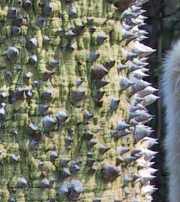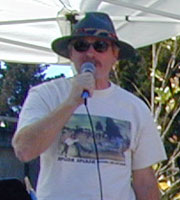In the iconic, blockbuster hit, “The Graduate,” Mr. McGuire famously predicts the future with a one-word pronouncement: ”plastics!” Forty years later, I’m prepared to make an equally authoritative prediction. The future (at least for gardens here in the Bay Area and throughout much of California) is in “succulents,” water-retaining plants well adapted to arid climate and soil conditions. This is predicated largely on climate changes resulting from global warming.
The key factor is not just the expected rise in temperatures, but also the decline in the Sierra snow pack that supplies one-third of the drinking water and irrigation supplies for the entire state, combined with a wholesale decline in rainfall totals statewide.
A March 28 article in USA Today reports that the water content of the snows in the 400-mile long mountain range is 46 percent of normal. In addition, the past year’s rainfall totals for selected California cities, according to the National Weather Service statistics published by SF Gate, is equally disturbing. Los Angeles suffered through its driest year in history with rain totals a mere 21 percent of normal. In Oakland, our 14 inches of rainfall was only 58 percent of normal.
In a few isolated pockets in the East Bay, our succulent future is already on display—and in Oakland quite prominently so in a small, front-yard at 730 Rand Avenue (map) directly behind Arizmendi on Lakeshore Avenue.
When Hayden Foell initially moved into this brown-shingle bungalow as a renter in 1995, he was itching to literally put down roots but had to contend with a less-than-enthusiastic landlord, who did eventually allow him to landscape a five-foot-wide strip between the sidewalk and a low wall that ran parallel to it. Foell and his long-time friend Brian Kemble—who has worked at the Ruth Bancroft Garden in Walnut Creek for twenty-seven years and is currently the Assistant Garden Director—journeyed to San Diego, which is a virtual Mecca for connoisseurs of succulents and cacti, and returned with specimen plants that now anchor the entire garden.
At one end where it spills over into the front yard of the adjacent apartment building, Foell and Kemble planted a one foot-high Agave salmiana. They told the owner of that building that it would eventually fill the space, but suspect he really didn’t comprehend. Over the last several months it’s done just that. Like other agaves, or “Century Plants,” it has a growth habit that culminates with one large massive bloom, followed by the plant’s demise. Currently, at 20-some feet, it probably has a few more feet to grow while the bloom continues to open. Although it’s less spectacular, a second agave at the other end of the garden began to flower just in the last month and it too is reaching skyward.
Foell notes that passersby have been taking note of his colorful and unusual garden for quite some time, but the two Agave blooms have caused a big spike (pun intended) in curiosity and visits from neighbors—including this reporter.
The other dominant feature in the garden is the large shade tree that was also part of the original planting. It’s a Kapok tree—commonly known as a Silk Floss. Native to South America, it’s the source for the fiber once widely used for pillows, mattresses, and sleeping bags. What makes this tree particularly cool, however, is a trunk studded with scales or spikes that remind me graphically of a Jurassic Era Stegosaurus.
When Foell purchased his home in 2000, his miniature “Berlin Wall” came down and succulents and cacti quickly began filling the previously bare space. Rock also emerged as an essential element in the aesthetics, providing natural-looking contours and niches. The first load of rock was purchased from American Soil Products, but subsequent loads have come primarily from construction sites in the Oakland hills.
Another key element in the garden design is in the use of “found materials”—much of which Foell has gathered during beach-combing expeditions, particularly at what is known as Junk Beach in Mendocino as well as at Point Albany on San Francisco Bay. Perhaps, the single most obvious of these objects in not found, but rather recycled. It’s an antique cast-iron radiator that was original to the Rand Avenue house. Foell turned it on one winter and, despite the fact it produced virtually no heat, his gas bill shot up to $400 for the month.
His decision to install a more-efficient unit, but not haul the old radiator to the dump, is totally in keeping with a resource conservation ethic that, in part, prompted StopWaste.Org to include Foell in last month’s fourth annual Bay-Friendly Garden Tour that focuses on water conservation, building healthier soils, conserving energy, creating wildlife habitats, and using recycled materials—all of which are exemplified by Foell’s unique garden.
Recently, Foell has been mulling over the possibility of expanding his horizons to include the Lakeshore Avenue freeway off ramp—specifically the long, steep embankment just across from what will soon be a Trader Joe’s. He envisions a lush, succulent oasis that will provide a dramatic entry to the Grand Lake commercial district. He believes this can be accomplished through plant donations and with volunteer labor for an extremely minimal cost. Perhaps, the very best selling point for his concept is that succulents will require little water and even less maintenance.
Foell will be publicly discussing his proposal for the very first time as part of a meeting of the Grand Lake Community Council this Thursday, June 7th, at the Grand Lake Neighborhood Center (map) beginning at 7 PM. If you’re interested in volunteering or simply want more information and can’t attend this meeting, please contact Hayden by email.
A succulent garden of one’s own?
If you want a succulent or cactus garden of your very own, a visit with Hayden Foell would be a good start. Major collections of succulents are also on view at the Ruth Bancroft Garden as well as the UC Berkeley Botanical Gardens. Succulents and cacti are available for sale at most nurseries including our own Ace Grand Lake Garden Center—as well as in the “From My Garden” booth at the Grand Lake Farmers Market. The best selection in the East Bay, however, is at Berkeley’s Dry Garden Nursery. Incidentally, when shopping at the Ace Grand Lake Garden Center, be sure to look for the labels provided by StopWaste.org identifying plants as California Natives and/or as drought-tolerant. They are one of eight East Bay nurseries participating in this innovative program.
In terms of culture requirements, Foell says that direct sun is required—although some plant selections require more than others. Also essential is soil with adequate nutrients and good drainage. In order to make his Rand Avenue garden grow, Foell added quantities of sand and pumice to break up the heavy, impenetrable clays that are typical of this area. The addition of quantities of rock also helps hold in moisture and, like mulch, helps crowd out weeds, eliminating the need for herbicides.
According to Jeanne Nader, a Project Manager at StopWaste.org, gardeners interested in learning conservation techniques can attend hands-on workshops or obtain a Bay Friendly Gardening Guide, as a 70+-page print publication (free for Alameda County residents) or downloadable
as a sequence of Adobe Acrobat pdf files.









Comments